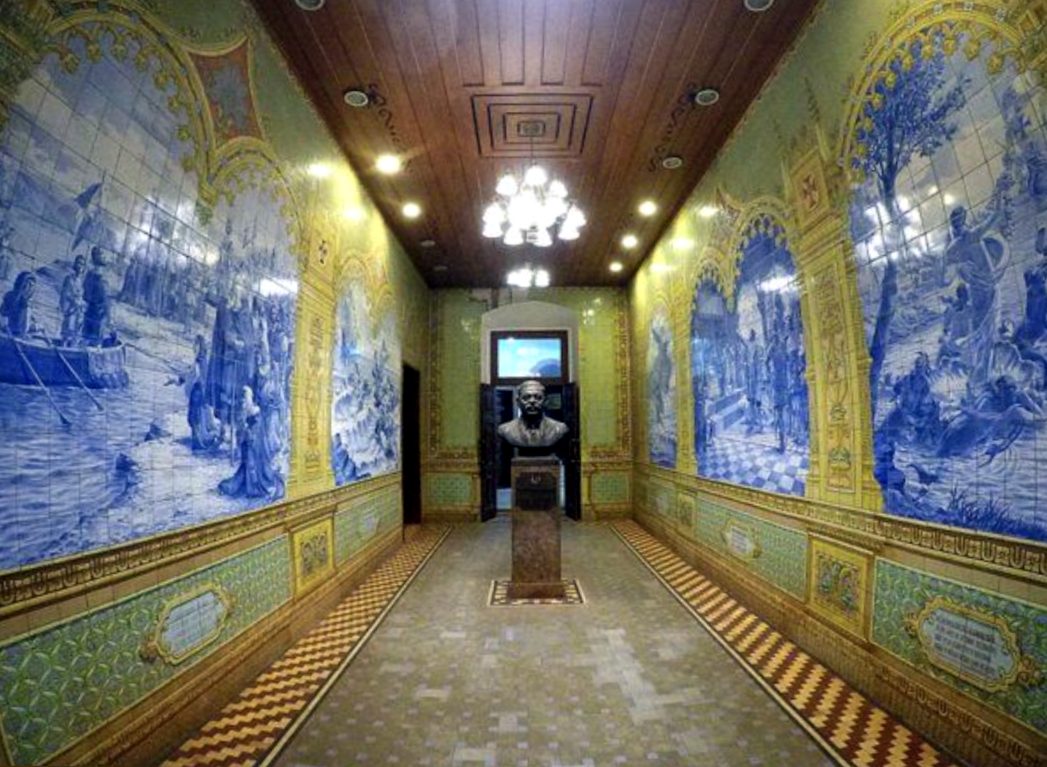PORTUGUESE AZULEJOS AND GOA - 2

Captivating white and blue Portuguese hand-painted ceramic tiles can be seen at the Institute Menezes Braganza in Panaji.
CALIFORNIA
In the 18th century, influenced by Baroque trends, narratives entered the art form of Azulejos. This is the period of the blue and white tiles you can see so many examples of, but that was a short window in Portugal’s Azulejos history.
During this century, churches and palaces became like books you could read, with stories and narratives told through their Azulejos.
During the reconstruction following the devastation of the great 1755 Lisbon earthquake, instead of restoring the original artworks, Azulejos tiles with repetitive geometric patterns were widely used as the work was fast and cheap. These tiles became known as “Pombalinos”, with a clear reference to Sebastiao José De Carvalho E. M. Pombal aka the Marquês de Pombal, the person mainly responsible for the reconstruction of Lisbon.
The 19th century saw Azulejos being put on the facades of buildings for the first time, embellishing the exteriors. The bourgeoisie began using Azulejos on their residences during this time to identify their houses and show they had importance and money. So Azulejos became a statement of a new class in society.
Then came the 20th century, the moment we see Azulejos used as urban art in the city squares, train stations and parks. The subway in Lisbon is considered one of the most beautiful in the world because it’s filled with Azulejos designed in the 1950s by Portuguese artist Maria Keil who passed away in 2012.
MAKING AZULEJOS TILES
The process begins with high-quality clay, which forms the base of the tiles. This clay is meticulously sourced and processed to achieve the desired consistency and strength. Artisans then apply glazes to the tiles, such as tin and lead glaze. The tin glaze creates a glossy white surface, while lead glaze allows for a vibrant range of colours.
After the glazing process, the tiles undergo firing in kilns at high temperatures. This firing process fuses the clay and glazes together, resulting in durable and long-lasting tiles that can withstand the test of time.
Sant'Anna in Lisbon is the oldest tile factory in Portugal and it's still operating! It has existed in the city since 1741, survived the catastrophic earthquake of 1755 that devastated much of Lisbon and still uses the traditional handcrafted techniques of old. Today, more than 90% of its production is sent abroad.
SOME EXAMPLES OF AZULEJOS
São Bento Railway Station in Porto is the quintessential place to find this ancient art. The station was built in 1903 and is covered with over 20,000 hand-painted tiles azulejo covering 550 square meters, by Portuguese artist Jorge Colaço depicting important historical moments from the North of Portugal, including the region's transportation evolution, crucial marriages, and defining conquests in Portugal's history.
Unbeknownst to me, the same Jorge Colaço (1868-1942) left his inedible mark in Panaji-Goa at the former Central Library – now officially known as the Krishnadas Shama Goa Central Library – where you can still see five floor-to-ceiling panels, on the ground floor of the Institute Menezes Braganza, painted in blue and white with ornate gold borders depict scenes from the Portuguese epic poem Os Lusíadas written by Luís Vaz de Camões, regarded as Portugal’s greatest poet. Each of these extraordinary panels bears an inscription at the bottom right: ‘Jorge Colaço, 3-7-1935’.
In Lisbon, another must-see is Casa do Ferreira das Tabuletas, the city's most photographed tiled façade, located in Chiado. Adorned with yellow and orange tiles, it depicts mythological images representing Earth, Water, Science, Agriculture, Commerce, and Industry. At the top, you'll find a star with a single eye symbolising the creator of the universe.
CONCLUSION
The art and history of Azulejos have left an indelible mark on Portuguese culture and heritage. These vibrant and intricate tiles have adorned buildings, churches, and public spaces for centuries, captivating the eyes and hearts of locals and visitors alike. The enduring legacy of Portuguese tile-making is a testament to the skill, creativity, and craftsmanship of the artisans who have dedicated themselves to this art form throughout history. [Concluded]
[The writer is an engineer retired in Silicon Valley. His interests include blogging, gardening, nature photography and traveling]